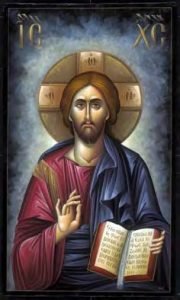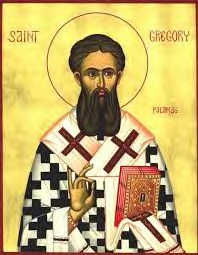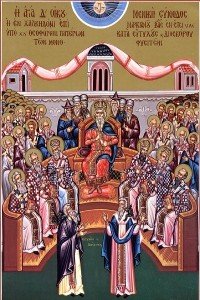TOPIC: Theology of Liturgy
By Len Mier
Thy Kingdom Come: Social Justice and Salvific Outlook in the Anaphora of St. Basil the Great Part 2

Salvation as Theosis
The essential act in the celebration of the holy mysteries is the transformation of the elements into the Divine Body and Blood; its aim is the sanctification (salvation) of the faithful. (Cabasilas, Hussey, & McNulty, 2010)
Salvation is the mission of all mankind, its goal is to become one again with the Holy Trinity. This state is best described in the beginning of the book of Genesis that we are to be once again in the perfect image and likeness of God, or deification. This is also found in the writings of St Basil. “Through the ‘soul’s operations’ of ‘man,’ it is possible to deploy this potential and to develop it into likeness of God when ‘man’ becomes what he/she was supposed to be from the beginning of the world.”(Druzhinina, 2016)
Olga Druzhinina in her book Ecclesiology of St. Basil the Great: a Trinitarian Approach to the Life of the Church states clearly:
‘The mystery of salvation’ in St Basil’s thought is perceived as the gradual process of human education in which they are brought to perfection in their training for godliness where godliness is always connected to the love toward others.(Druzhinina, 2016)
Another dimension to Theosis and salvation is, “a life in communion with Jesus Christ will be characterized by generosity to the needy human beings in whom the Lord is present.”(LeMasters, 2015)
The anaphora: the basis for Philanthropia (Φίλάνθρωπίά)
St Basil’s liturgy as taken in my local parish setting does not do justice to the beauty and nature of this anaphora. Because of its length, many of the prayers are said in a quiet voice by the priest while the congregation sings their part of the liturgy, rendering the worshiper to read the anaphora to themselves or reading it outside of the actual liturgy in order to appreciate the meaning.
Paraphrasing Fr Schmemann, the predominate practice of the priest reading the prayers secretly in a voice inaudible to the people, often with the doors closed and curtain drawn, has the practical effect of the prayer being dropped from the church service. (LeMasters, 2015) It was only when reading the whole anaphora outside of the liturgy do you see the philanthropic and salvific themes emerge.
Liturgy in general tends to be separated from daily life for most Christians. We see liturgy as the work of the people only to worship God. This narrow view of liturgy can be reversed if we look at one line from one prayer in the liturgy. The line I am talking about is from the Lord’s Prayer, “Thy will be done on earth as it is in heaven”. It has been stated, “There is a certain social ethic that is loaded into that phrase, when we remove the social aspect from liturgy we see a, ‘failure of correspondence between liturgy and ethics which amounts to an understandable separation between the sacred and the secular’. It is all too often true of Eastern Orthodoxy.”(LeMasters, 2015) This can be said of most liturgical Christian experiences.
Philanthropia is what St Basil was preaching in his homilies on social justice, the work of the people to see and care for the poor. The English word philanthropy is derived from this word and its understanding is clear to the modern reader. This Philanthropia is the strong social ethic that we as Christians must have for each other. This is the merging point of Christian ethics with that of liturgical theology.
Christian ethics is an ethics of the Great Supper because it is in eucharistic assembly, not in private prayer or study, that judgment, repentance, reconciliation, and God’s love are experienced in their full Kingdom signification.(LeMasters, 2015)
Beside St Basil, St John Chrysostom also spoke in terms of Philanthropia in his homily on Matthew 25:31-46, the last judgment, and in his homily on Second Corinthians, “The Hungry”.
It is a social order of simple living and care for one’s fellow man that St Basil envisioned in the Basiliad, his monasteries. Basil incorporated these themes into his anaphora, Petitions and prayers are not meant to be rhetorical exclamations poetic romanticisms, or supplications for God alone to hear; they are meant to penetrate man’s heart and mind and become impetus for agape in diakonia – love in practice. An invitation to the metamorphosis of the congregation as well as society.(LeMasters, 2015)
In the liturgy of St Basil he “unites thanksgiving and supplication throughout the liturgy in a way that proclaims God as supreme benefactor of the human race.”(Cabasilas et al., 2010)
From the very start of the anaphora we hear that we will “recount all your (God’s) mighty deeds in every age”(Catholic, Byzantine Liturgical, & Intereparchial Commission for Sacred, 2006) Basil in the anaphora elaborates God’s philanthropy to mankind in a recounting of those things He has done for us. Here is but a small list that St Basil gives us: the gift of filial adoption, the pledge of our future inheritance, and the First-fruits of eternal blessings given to us.
We are told that taking man from the earth formed him and honored him with your own image and placed him in paradise with the promise of immortal life and eternal blessings. God showed us the ultimate mercy after our own transgression of disobedience, and His banishing us from paradise and returning us to the earth from which we came. He provided us with salvation and rebirth in His Christ, not forsaking the work of his hands.
St Basil goes on to tell us God gave us the Law as an aid, and sent us servants and prophets to tell us of the salvation of which was to come.
(To be continued)
 Spirituality in the Christian East means the everyday activity of life in communion with God. The term spirituality refers not merely to the activity of man’s spirit alone, his mind, heart and soul, but it refers as well to the whole of man’s life as inspired and guided by the Spirit of God. Every act of a Christian must be spiritual, every word, every deed, every activity of the body, every action of the person. This means that all that a person thinks, says and does must be inspired and guided by the Holy Spirit so that the will of God the Father might be accomplished as revealed and taught by Jesus Christ, the Son of God. Doing all things to the glory of God is the meaning and substance of life for a human being. This “doing” is what Christian spirituality is about.
Spirituality in the Christian East means the everyday activity of life in communion with God. The term spirituality refers not merely to the activity of man’s spirit alone, his mind, heart and soul, but it refers as well to the whole of man’s life as inspired and guided by the Spirit of God. Every act of a Christian must be spiritual, every word, every deed, every activity of the body, every action of the person. This means that all that a person thinks, says and does must be inspired and guided by the Holy Spirit so that the will of God the Father might be accomplished as revealed and taught by Jesus Christ, the Son of God. Doing all things to the glory of God is the meaning and substance of life for a human being. This “doing” is what Christian spirituality is about.
 I have been sharing information about the “CANON” of the New Testament. In modern times, when the problem of authorship has been divorced from that of canonicity, the sharp distinction evident between the style of Hebrews and that of the Pauline writings has convinced most scholars that Paul was not the author. Catholic writers, influenced by the decree of the Pontifical Biblical Commission, have tried to protect the Paulinity of Hebrews by stressing that Paul used a scribe to write the epistle. Now, however, they are beginning to recognize that Hebrews probably has no real relation to Paul, other than that the author may have had some acquaintance with thought like Paul.
I have been sharing information about the “CANON” of the New Testament. In modern times, when the problem of authorship has been divorced from that of canonicity, the sharp distinction evident between the style of Hebrews and that of the Pauline writings has convinced most scholars that Paul was not the author. Catholic writers, influenced by the decree of the Pontifical Biblical Commission, have tried to protect the Paulinity of Hebrews by stressing that Paul used a scribe to write the epistle. Now, however, they are beginning to recognize that Hebrews probably has no real relation to Paul, other than that the author may have had some acquaintance with thought like Paul. More on the second. With hands raised in prayer the Mother of God reminds us to Whom worship is due. It is the symbol of each Christian and also of the Church. It is the many forms of liturgy – the Divine Liturgy, Akathysts, Matins and Vespers –the prayers of a community of believers as well as personal prayers. It is the whole fabric of human existence at rest and at play, in daily tasks, in suffering and in celebration. All of these can become part of our prayer life if we so choose. As the Mother of God stands there in eternal prayer, she gives us Christians confidence of the closeness to Our Father, Who hears us and is merciful.
More on the second. With hands raised in prayer the Mother of God reminds us to Whom worship is due. It is the symbol of each Christian and also of the Church. It is the many forms of liturgy – the Divine Liturgy, Akathysts, Matins and Vespers –the prayers of a community of believers as well as personal prayers. It is the whole fabric of human existence at rest and at play, in daily tasks, in suffering and in celebration. All of these can become part of our prayer life if we so choose. As the Mother of God stands there in eternal prayer, she gives us Christians confidence of the closeness to Our Father, Who hears us and is merciful.
 Although I realize that this article, which deals with the “mystery and wonder of the Trinity” as expressed by the debates of the Fathers of the Church, may be difficult to follow and understand, I think it is valuable. What I think it does is document the thinking of the Church as she came to understand God as Three-In-One – as a Trinity of Persons. In order to come to this understanding, there were many very important issues that had to be dealt with. As you probably know, the Trinity is not overtly dealt with in the New Testament. The early Church did not have a clear understanding of the belief in the Trinity. It took more than 300 years and, obviously, the challenge of heresy to make the Church deal with Who God Is, based on Who she believes Jesus is. Truly, the development of the idea of God as Three-In-One came about as the Church attempted to understand Who Jesus Is. If He truly is God incarnate, somehow, in order to preserve the understanding of God as One and beyond nature, there must be a second Person, the Son. Then to believe that God, in the Person of the Son became human, there must be a Person that represents the Power of God who brought that all about. Thus, the Fathers began to develop the idea of the Trinity.
Although I realize that this article, which deals with the “mystery and wonder of the Trinity” as expressed by the debates of the Fathers of the Church, may be difficult to follow and understand, I think it is valuable. What I think it does is document the thinking of the Church as she came to understand God as Three-In-One – as a Trinity of Persons. In order to come to this understanding, there were many very important issues that had to be dealt with. As you probably know, the Trinity is not overtly dealt with in the New Testament. The early Church did not have a clear understanding of the belief in the Trinity. It took more than 300 years and, obviously, the challenge of heresy to make the Church deal with Who God Is, based on Who she believes Jesus is. Truly, the development of the idea of God as Three-In-One came about as the Church attempted to understand Who Jesus Is. If He truly is God incarnate, somehow, in order to preserve the understanding of God as One and beyond nature, there must be a second Person, the Son. Then to believe that God, in the Person of the Son became human, there must be a Person that represents the Power of God who brought that all about. Thus, the Fathers began to develop the idea of the Trinity.